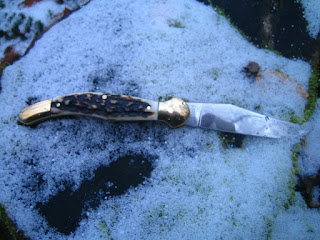Also on the recent Jaagd und Hund expo I met with István Nagyi, who gave to me this beautifully accomplished Hungarian shepherd´s knife. Those who know me know that I am not overly fond of slipjoint mechanisms on a backwoods knife. This knife, however, is dating back to the 17th century and it is a time-proven design. It feels sturdy and is not very prone to snapping back in accidentally. Why, you ask? If you look closely at the dsign of the pivot you realize that the spring is part of the "guard" and the pivot is very off-center. This moves the pivot out of the center of the levering action of an accidental snap-in. Plus, the working hand gets to rest on the spring giving additional safety. Of course, it is still a slipjoint knife, aand you have to be more careful, but let´s look at the overall layout... it is no prybar in the first place. It is a knife for snacking and easy whittling and cutting tasks.
The blade is handforged (!) from 440C and came, while not hair-poppingly sharp, with a satisfying sharpness. 1mm above the edge line the blade is just 0,4 mm thick. In the spine it is 2 mm with a high flat grind. Snacking is a cinch. You can cut thin slices of hard, dried sausage with no problems and make short terms with aged bacon and cheese, fruits and vegetables alike.
The handle, made from brass and beautiful red deer scales gives the hand very good support while lending a very dexterous feeling to the knife. The knife is a joy to look at, to use and carry. It came with a sturdy leather case with a strop.
No, it is not a hardcore tactical or bushcraft knife, but as a secondary carry for processing food and snacking, it is one of the best knives I own. The Yatagan blade is reminiscent of a Laguiole design, but the handle gives far more support to the had than a Laguiole, as good as this style of knife generally is.
You can get this style of knife from many makers in Hungary-go get yourself one and enjoy! ;-)
Those are the adventures of Mr. Fimbulmyrk, in bushcraft and blacksmithing, mountainbiking and hiking, reenactment, writing, singing, dancing, stargazing and having a piece of cake and a coffee. Pray have a seat and look around you, but be warned - the forest´s twilight is ferocious at times.
Beliebte Posts
-
You all have read my post about the Knifemaker´s Fair in Solingen Klingenmuseum which...
-
On request I am doing a personal evaluation of a very classic bushcraft combination. The famed Roselli hunter and carpenter´s knife. I pur...
-
This is part of my not exactly tiny collection of German hunting knives, representatives of a very distinct and ancient style of knife. Y...
-
On Saturday the magic troll was being on air with her folk band in her living room, "Molly Malone´s Irish Pub" in Marburg , and,...
-
This is my collection of traditional Hungarian hunting knives. I am quite interested into the ethnographical and morphogenetic influences of...
-
This is somewhat of an edit of an ancient post from way back then. But as is, the times have changed a lot, and so has my persp...
-
I had found an old graphite electrode in the woods and thought I would like to try to make a pen after the concept by Konrad Gessner (https:...
-
I was feeling inspired by some Chinese guy making cups from Reishi mushrooms and thought I would give it a go. I used tinder conk/horse...
-
It´s been a while coming, but now I have my resolve on how to do it. I already stitched the backside of the bag.The rings are from the m...
-
...and this came out. Kai helped a bit with the grinding, but Levin forged it out all by himself with no tutoring whatsoever. The shape wa...











